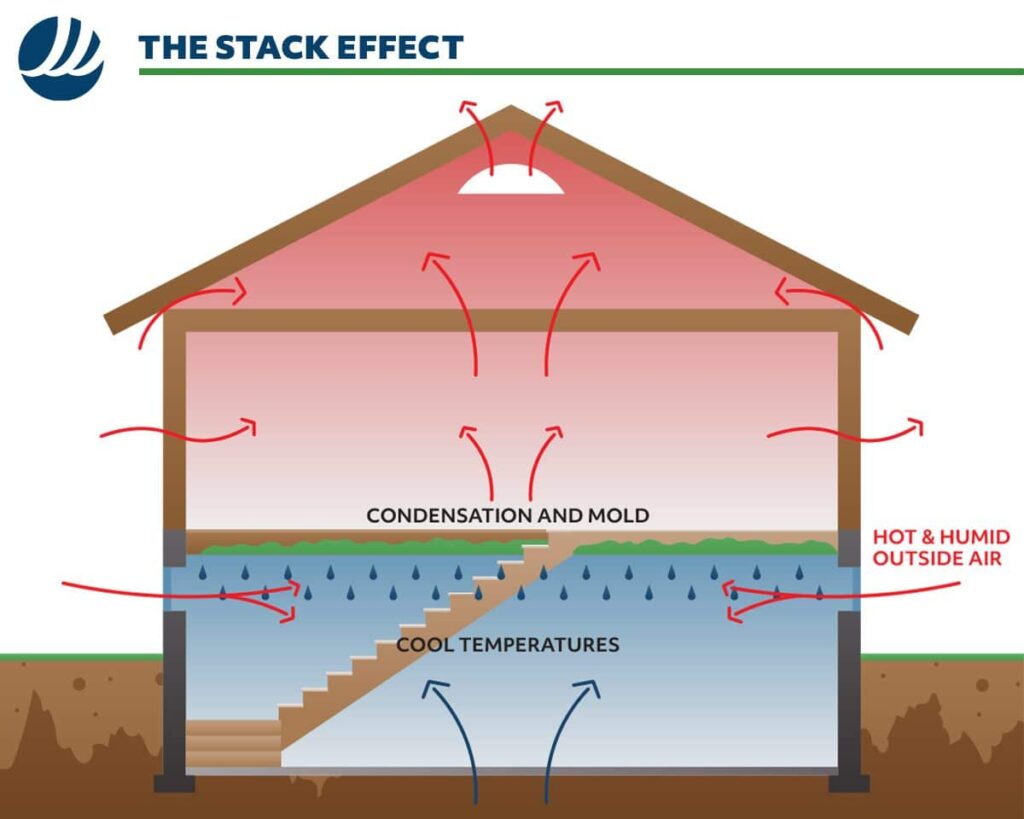
Thinking about an interior basement drainage system for your home? Believe it or not, basements aren’t destined to be damp, uninviting places. An interior basement drainage system can make your basement dry enough to live in.
In this article, we’ll go over why basements tend to be damp, how an interior basement drainage system works, signs your home might need a basement drainage system, and more.
Why Do Basements Tend To Be Damp?
Basements tend to be damp because they’re underground or “below grade,” as they say in the construction industry. In other words, they’re surrounded by soil. If there’s poor drainage, the basement is also surrounded by a lot of water. This is a problem because excess water in the soil leads to the build-up of hydrostatic pressure. We’ll talk more about hydrostatic pressure in just a bit because it’s key to understanding why an interior basement drainage system is the most effective waterproofing solution.
Basements also become damp because open windows during the summer allow warm, humid air to enter the basement and condense on colder surfaces.
Other reasons for damp basements include showers, cooking, using a washing machine and dryer, etc.
For more information see Is Basement Waterproofing Worth It? Yes!
Why You Don’t Want a Damp Basement?
You don’t want a damp basement because dampness leads to mold growth. You don’t want mold growth because a certain percentage of air in the basement enters your home’s living area due to a phenomenon called the “stack effect”:
ultimately lead to structural damage and costly repairs. More on this below.
You can’t do much with a damp basement. You don’t dare store anything valuable in a damp basement, and you certainly can’t finish the basement and use it as a living area. About all you can do is use the basement as a laundry room. That’s a lot of wasted space. But, there’s some good news. An interior basement drainage system will make your basement dry enough to live in or store valuables.
Before we talk about how a drainage system works to keep your basement dry, we need to go over hydrostatic pressure.
Hydrostatic Pressure
Poor drainage in the soil around your home’s foundation will cause hydrostatic pressure to build up and push against the foundation (i.e., basement) walls. Hydrostatic pressure exerts an enormous force against foundation walls, strong enough to crack the walls and cause them to bow inward. This not only creates a way for water to enter the basement but also affects the home’s structural integrity because those walls hold up your house, literally. You don’t want them bowed and cracked.
Fortunately, there’s a way to keep excess moisture from building up in the soil around the foundation: an interior basement drainage system.
How an Interior Basement Drainage System Works?
An interior basement drainage system works by ensuring there’s no excess water in the soil around the foundation. Any excess moisture in the soil gets channeled into a sump pit and then released away from the foundation via a sump pump. The general installation procedure is as follows:
- The contractor uses a jackhammer to break up your basement floor.
- A shallow trench is then dug around the inside perimeter of the basement and lined with gravel.
- A perforated drainage pipe is placed in the trench and covered with more gravel.
- If the basement isn’t going to be finished, the trench is sometimes left open, with just the gravel covering the drainage pipe. If the basement will be finished, the slab is always replaced.
Any excess water in the soil now flows into the drainage pipe and gets channeled toward the sump pit. When the sump pit is full, the sump pump expels the water away from the foundation.
An interior basement drainage system makes it impossible for hydrostatic pressure to build up because it keeps the soil around the foundation dry. When the soil around your home’s foundation is dry, your basement will be dry. Compare this waterproofing method with merely putting up a barrier to keep water out. Eventually, those barriers fail, and you’re back where you started.
Signs Your Home Might Need an Interior Basement Drainage System
Signs you might need an interior basement drainage system include:
- A musty smell in your basement
- A musty smell in your home’s live area – Remember, some of the air from the basement flows up and into the living area.
- High humidity
- Efflorescence on walls
- Rust on basement structures or items stored in the basement
- Water tricking down basement walls
- Condensation
- Pooled water on the basement floor
- Mold growth
Other Ways To Prevent Water From Getting Into Your Basement
While an interior basement drainage system is a basement waterproofing gold standard, there are other things you can do to control groundwater around your home’s foundation. These include:
- Regrade your yard – if necessary – so water doesn’t drain toward the foundation.
- Clean your gutters regularly – Clogged gutters cause water to flow over the side of the home and into the soil next to the foundation.
- Install downspout extensions – If your downspouts are too short, they’ll dump water too close to the foundation. Downspout extensions carry water away from the foundation before releasing it.
- Install an underground downspout and pop-up emitter – Water from your gutters flows into the underground downspout and toward the pop-up emitter situated 10 feet or so away from the foundation. The pop-up emitter is barely visible on your lawn. However, when it fills with water, it pops up and releases the water at a safe distance from the foundation. After the water is released, the pop-up emitter drops back down and becomes invisible again.
- Don’t plant water-hungry vegetation near the foundation.
If you think your home might need an interior basement drainage system or services relating to basement waterproofing or foundation repair in Kansas City, contact us today for an inspection and estimate.












